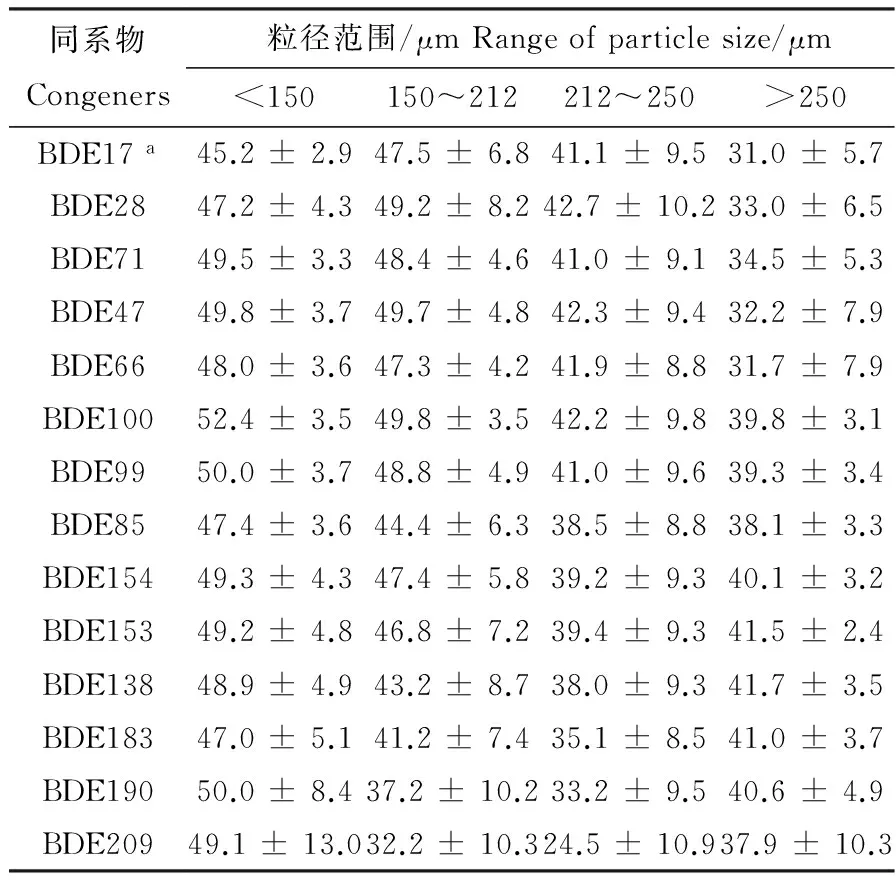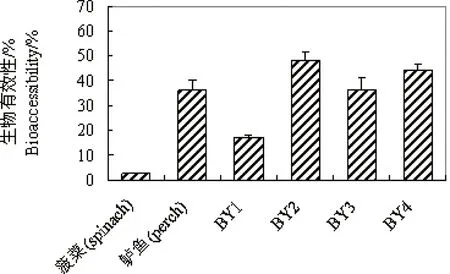食物粒径与混合方式对多溴联苯醚生物有效性的影响
娄素芳,黄宁宝,徐丽,余应新,2,*
1. 上海大学环境与化学工程学院 环境污染与健康研究所,上海 200444 2. 中国科学院城市环境研究所 城市环境与健康重点实验室,厦门 361021 3. 上海大学环境与化学工程学院 化学工程与工艺系,上海 200444
食物粒径与混合方式对多溴联苯醚生物有效性的影响
娄素芳1,黄宁宝1,徐丽3,余应新1,2,*
1. 上海大学环境与化学工程学院 环境污染与健康研究所,上海 200444 2. 中国科学院城市环境研究所 城市环境与健康重点实验室,厦门 361021 3. 上海大学环境与化学工程学院 化学工程与工艺系,上海 200444
多溴联苯醚(PBDEs)是一类典型的持久性有机污染物(POPs),口服摄入是其主要人体暴露途径。口服生物有效性是污染物健康风险评估中的关键因子。论文采用体外方法模拟食物在人体肠道中的消化过程,研究了食物粒径大小以及食物污染与混合方式对PBDEs生物有效性的影响。在<150、150~212、212~250和>250 μm四个粒径范围的胡萝卜中,PBDEs同系物的平均生物有效性分别为48.8% ± 3.8%、45.2% ± 5.0%、38.6% ± 9.3%和37.3% ± 3.7%。测得菠菜和鲈鱼采用4种混合方式BY1、BY2、BY3和BY4中PBDEs同系物的平均生物有效性分别为17.1% ± 1.3%、48.3% ± 3.5%、36.4% ± 4.9%和44.4% ± 2.0%,比单纯菠菜(2.6% ± 0.2%)和鲈鱼(36.3% ± 4.3%)中的生物有效性高。结果表明,PBDEs的生物有效性随着胡萝卜粒径的增大而减小;不同污染方式再混合食品,比单一食品被污染时,PBDEs的生物有效性更高。
多溴联苯醚;生物有效性;食品;持久性有机污染物;模拟胃肠液
Received 18 November 2015 accepted 4 January 2016
多溴联苯醚(PBDEs)是一类典型的持久性有机污染物(POPs)。这类污染物在环境中难以降解,但易通过大气、水以及迁徙动物等远距离迁移,分布到远离污染源的地方。由于其扩散导致全球性的污染而广受关注,目前部分PBDEs已经被《关于持久性有机污染物的斯德哥尔摩公约》列为优先控制的污染物[1]。经口摄入是PBDEs暴露于人体的主要途径[2]。它们通常是通过结合或吸附在环境介质上(如食品、灰尘)经口摄入。
实际上,污染物在肠道中能否被吸收与其口服生物有效性(bioaccessibility)有关。它是指污染物在消化过程中从基质中释放到肠液部分的量占总量的比例,它反映了污染物能被肠道吸收的最大程度,通常利用人工胃肠液模拟物质在肠道中的消化过程测定[3-4]。物质的生物有效性通常受到基质的类型和性质的影响,如对食品的不同处理方式会使得食品的结构产生改变,进而影响物质的生物有效性。Netzel等[5]研究发现热处理和机械均质化会破坏植物基质的细胞壁,能提高Caco-2细胞(一种肠癌细胞)吸收胡萝卜中类胡萝卜素的量。由于食物是经口摄入,除了进入口腔前,食物的状态会影响污染物或营养物在肠道中的吸收外,经口咀嚼后,食物的粒径也将发生改变,进而影响物质在肠道中的释放,而这一点经常在体外模拟实验中被忽视,只有少数研究有明确的机械粉碎过程来模拟口腔咀嚼[6-7]。Lemmens等[7]研究表明β-胡萝卜素的生物有效性在生胡萝卜中比热处理过的胡萝卜中受粒径的影响更大。而目前,食品粒径对污染物生物有效性的影响还未见报道,考虑粒径的影响,能完善体外模拟技术,更好地评估污染物对人体的暴露风险。
除了粒径外,食品成分也可对污染物或营养物的生物有效性产生影响。我们前期研究发现,滴滴涕及其代谢物的生物有效性与食品中蛋白质及膳食纤维的含量呈负相关,与碳水化合物的含量和热量呈正相关[8];在研究PBDEs生物有效性时也有类似的发现,并建立了PBDEs生物有效性和这些成分之间关系的数学模型[9]。Jiwan等[10]发现有机和无机婴儿食品中类胡萝卜素的生物有效性与食品中脂肪、膳食纤维、碳水化合物和其他类胡萝卜素有关。最近也有金属和多环芳烃(PAHs)的相关研究[11-12]。然而,这些研究多采用的是单一食品,将这些测定的生物有效性用于人们的日常饮食过程中污染物对人体暴露评估会带来较大误差,因为人们日常饮食过程中,脂肪或油脂与其他营养物质如蛋白质、碳水化合物和膳食纤维是同时摄入,需要考虑混合食品中食品的不同污染状态对污染物释放的影响,为合理搭配食物,减少污染物的人体暴露风险提供理论依据。
为此,本研究主要开展了以下工作:(1)以胡萝卜为例,分<150、150~212、212~250和>250 μm四个粒径范围,制备受PBDEs污染的不同粒径胡萝卜,研究不同粒径对PBDEs生物有效性的影响;(2)以菠菜和鲈鱼为例,用4种不同加标混合方式模拟不同的污染混合食品,探讨不同污染混合方式对PBDEs生物有效性的影响。
1 材料与方法 (Materials and methods)
1.1 主要试剂
胶质(pectin from apples)、(+)-阿拉伯半乳聚糖(arabinogalactan from larch wood)和木聚糖(xylan from birch wood)购自美国的Fluka公司;土豆淀粉(starch from potato)、葡萄糖(D-(+)-glucose,SigmaUltra,99.5% GC)、粘蛋白(mucin from porcine stomach,Type Ⅱ)和胆粉(bile bovine)购自美国的Sigma公司;蛋白胨(peptone from poultry)、胃蛋白酶(pepsin from porcine gastric mucosa)、胰酶(pancreatin from porcine pancreas,350 FIP-U/g (activated) protease,6000 FIP-U/g lipase,7500 FIP-U/g amylase)和酵母粉(yeast extract)购自德国的Merck公司;其他化学试剂(分析纯)购自上海国药集团(Sinopharm Chemical Reagent Co. Ltd)。
饱腹状态的模拟消化液包括:营养液、胃酸、胃液和小肠液。这些消化液的制备依据SHIME配方配制,具体如下。营养液:用2 L的玻璃瓶取1 L纯水,在121 ℃灭菌25 min。冷却到室温后,向其中加入1 g阿拉伯半乳聚糖、2 g胶质、1 g木聚糖、3 g土豆淀粉、0.4 g葡萄糖、3 g酵母粉、1 g蛋白胨、4 g粘蛋白和L-半胱胺酸0.5 g,最后震荡均匀。胃酸:向1 L的容量瓶中加入8.6 mL的浓盐酸,然后加入灭菌过的纯水,定容到刻度线,配制成0.1 mol·L-1的HCl溶液。接着把HCl溶液倒入1 L的玻璃瓶中,并向其中加入0.09 g 活性单位为700 FIP-U·g-1的胃蛋白酶,最后震荡均匀。胃液:取400 mL营养液和50 mL胃酸混合得到pH值为3.0 ± 0.1的胃液。小肠液:取1 L无菌水溶液,向其中加入12.5 g NaHCO3、6.0 g胆粉和0.9 g胰酶,摇荡均匀。
1.2 样品采集和前处理
从市场采集的胡萝卜样品,用搅拌机磨碎,冷冻干燥后再打碎成粉末,过不锈钢筛网筛分出<150、150~212、212~250和>250 μm四个粒径样品,密封避光-20 ℃冷藏保存待分析。菠菜、鲈鱼和草鱼样品采集自上海地区超市和菜市场,同上,冷冻干燥后搅拌机打碎成粉,-20 ℃冷藏保存。
制备受PBDEs污染的样品过程:向40 mL棕色瓶中加入约1 mL二氯甲烷,后加入18 ng的3-7溴PBDEs和90 ng的BDE209,然后准确称量0.2 g样品加入其中,轻轻震荡使其混合均匀,最后用微弱的氮气流吹干,老化7 d后使用。
将0.1 g菠菜和0.1 g鲈鱼制成4种不同加标混合样品:(1)菠菜加标老化后与不加标鲈鱼混合(BY1),(2)鲈鱼加标老化后与不加标菠菜混合(BY2),(3)菠菜和鲈鱼分别加标老化后混合(BY3),(4)菠菜和鲈鱼混合后加标老化(BY4)。
1.3 生物有效性的测定
取0.2 g的样品加入到12 mL模拟胃液中,在37 ℃下消化2 h,混合物的pH值为3。然后加入6 mL模拟小肠液,此时pH在7.0左右,胆汁浓度为2 g·L-1。消化6 h后,将混合物在8 118 r·min-1下离心10 min。上清液过0.45 μm的聚丙烯纤维膜后,加入回收率指示物13C-PCB141,用丙酮和正己烷:二氯甲烷(1/3,V/V)溶液萃取3次。残渣用丙酮(3 × 20 mL)超声萃取(每次30 min),萃取液过无水硫酸钠后,加入回收率指示物13C-PCB141。上清液和残渣的萃取液均用浓硫酸处理后,用酸碱硅胶-氧化铝复合层析柱和凝胶渗透色谱柱(GPC)净化。加入内标13C-PCB208,氮吹浓缩后,用异辛烷定容至一定体积,样品密封保存于-20 ℃冰箱待分析。
1.4 仪器分析
PBDEs分析在配备负化学离子源(NCI)的Agilent 6890N/5975 GC/MS上完成。3-7溴BDE分析的色谱柱为DB-5MS毛细管色谱柱(30 m × 0.25 μm × 0.25 μm,J&W Scientific,USA),以高纯氦气为载气,柱流速为1 mL·min-1。升温程序为:110 ℃保留1 min后以8 ℃·min-1升至180 ℃,保留1 min,以2 ℃·min-1升至240 ℃,保留5 min,再以2 ℃·min-1升至280 ℃,保留5 min,以20 ℃·min-1升至300 ℃,保留15 min。BDE209的分析色谱柱为DB-5MS毛细管色谱柱(12 m × 0.25 μm × 0.1 μm,J&W Scientific,USA),柱流速为2 mL·min-1;升温程序为:110 ℃以10 ℃·min-1升至300 ℃。进样口、连接口和离子源温度分别为280 ℃、290 ℃和250 ℃。1 μL无分流进样,采用选择离子模式(SIM)。3-7溴BDEs扫描离子m/z为79和81,BDE209为486.7和488.7,13C-PCB141为372和374,13C-PCB208为476和478。
1.5 质量保证与质量控制
每组实验有一个方法空白,空白测定的值作为背景值,样品的实测值将扣去该值。用浓度范围为0.5~300 ng·mL-1的7个PBDEs标样建立标准曲线进行PBDEs的定量分析,校正曲线的相关系数均大于0.99。3-7溴BDEs和BDE209的仪器检出限分别为0.3~0.9 pg和3.6 pg。13C-PCB141的回收率为89.0%± 9.3%,数据未进行回收率校正。
玻璃器皿先用含有洗洁剂的自来水,50 ℃超声30 min,然后120 ℃烘干,接着过含5%重铬酸钾的浓硫酸溶液,取出放置4 h后用自来水、蒸馏水依次冲洗,盖上锡箔纸后,再次在烘箱120 ℃烘干后使用。
1.6 生物有效性计算
PBDE单体的生物有效性(Ba)的计算式为:
式中ms-p为加标样品经消化后释放到消化液中PBDE单体的质量(ng);m为加入PBDE单体的质量(ng)。
2 结果与讨论(Results and discussion)
2.1 粒径对生物有效性的影响
本研究中,不同粒径胡萝卜中PBDEs的生物有效性见表1。在<150、150~212、212~250和>250 μm四个粒径范围的胡萝卜中,PBDEs的平均生物有效性分别为48.8% ± 3.8%、45.2% ± 5.0%、38.6% ± 9.3%和37.3% ± 3.7%(图1)。从图1可以发现,随着胡萝卜粒径的增大,PBDEs的生物有效性呈现下降趋势。
食品中营养物质的生物有效性也有类似的研究。Tydeman等[13]研究了不同加工处理后的胡萝卜中类胡萝卜素在胃液的释放,发现胡萝卜丝和胡萝卜汁释放的比例(20.8% ± 3.0%和96.8% ± 4.2%)比胡萝卜块(4.5% ± 0.7%)大,且随着胡萝卜的表面积增大,类胡萝卜素在消化液中的分配量也增大。Lemmens等[7]在研究粒径对β-胡萝卜素生物有效性的影响时,发现随着胡萝卜粒径的减小,β-胡萝卜素的生物有效性显著升高,且细胞破裂是β-胡萝卜素生物有效性升高的先决条件。

表1 不同粒径胡萝卜中PBDEs的生物有效性(%)
注:平均值±标准偏差。
Note: Mean ± standard deviation.
本研究中PBDEs的生物有效性也与这些研究有类似的结果。随着粒径的减小,相同质量胡萝卜颗粒的表面积增加,胡萝卜与消化液的接触面积增大,提高了表面活性剂(如胆汁)的乳化作用,促进PBDEs在消化液中的释放。另外,经过老化,在加标污染的胡萝卜颗粒上,PBDEs不仅存在于颗粒表面,也有部分可能会进入到胡萝卜细胞簇的细胞或细胞间隙中,由于磨碎作用,颗粒粒径减小,破裂的细胞增多,颗粒中PBDEs的封存位点减少,在消化液的作用下这些PBDEs也就越易释放。

图1 不同粒径胡萝卜中PBDEs的平均生物有效性Fig. 1 Average bioaccessibility of PBDEs in carrot with different particle sizes
此外,我们前期的研究发现,食物中PBDEs的生物有效性与碳水化合物的含量呈显著正相关[9],碳水化合物作为胡萝卜主要含有的营养素,也可能是导致本研究结果的一个因素。营养素的释放取决于颗粒粒径减小的模式(细胞分离或细胞破裂)[14],而搅拌磨碎能导致生胡萝卜细胞破裂[15],因此本研究中胡萝卜的颗粒粒径减小,会促进细胞中碳水化合物的释放,在消化过程中,释放得越多,越有利于PBDEs生物有效性的提高。
2.2 混合食品对生物有效性的影响
据报道,与单一食品不同,混合食品对于痕量物质生物有效性的影响是无法预测的,既有可能增强,也有可能减弱[16]。为研究混合食品对生物有效性的影响,本文以菠菜和鲈鱼为例,人为制备了不同污染的混合样品,通过模拟人体胃肠消化过程测定混合食品中PBDEs的生物有效性。对于这2种食物,菠菜除水分外的营养成分主要以蛋白质、碳水化合物和膳食纤维为主,分别占干重的30.4%、31.6%和17.7%[17];而鲈鱼则以蛋白质和脂肪为主,分别占干重80.4%和19.6%。
我们前期研究发现,作为单一食品时,受污染的菠菜和鲈鱼中PBDEs的平均生物有效性分别为2.6% ± 0.2%[9]和36.3% ± 4.3%[18]。当添加另一食品后,所测食品中PBDEs的生物有效性均有所改变(表2),如BY1中PBDEs的平均生物有效性为17.1% ± 1.3%(图2),比菠菜中提高了5倍,但却比鱼体中的要低。BY2中的平均生物有效性为48.3% ± 3.5%(图2),比鱼体中提高了33.1%。

图2 不同混合食品中PBDEs的平均生物有效性 注:BY1,菠菜加标老化后与不加标鲈鱼混合;BY2,鲈鱼加标老化后与不加标菠菜混合;BY3,菠菜和鲈鱼分别加标老化后混合;BY4,菠菜和鲈鱼混合后加标老化。Fig. 2 Average bioaccessibility of PBDEs in food with different mixed methodsNote: BY1, Spinach spiked with PBDEs and aged then mixed with perch which PBDEs were not added; BY2, Perch spiked with PBDEs and aged then mixed with spinach which PBDEs were not added; BY3, All spinach and perch spiked with PBDEs and aged then mixed each other; BY4, Mixed spinach and perch and then spiked PBDEs.
不同食品具有不同的化学组成及性质,因此其对PBDEs生物有效性的影响也不相同。我们前期研究发现,PBDEs的生物有效性与脂肪含量和碳水化合物成正相关,与蛋白质和膳食纤维成负相关;当食品中的脂肪含量超过5.5%时,脂肪对PBDEs生物有效性的影响最大,对于动物性食品,脂肪是影响PBDEs生物有效性的主要因素[9]。食品中的脂肪含量与PCBs生物有效性之间也具有显著的线性正相关关系[19]。类似的结果在对土壤中PAHs的研究也有发现,当添加脂质后,PAHs的生物有效性显著提高[12]。本研究中鲈鱼的脂肪含量为19.6%,因此加入鲈鱼后,BY1中PBDEs的生物有效性明显的提高。而对于植物性食品,碳水化合物、蛋白质和膳食纤维共同影响PBDEs的生物有效性[9]。菠菜较鲈鱼含有更多的碳水化合物和膳食纤维,且碳水化合物的含量比膳食纤维高,因此加入菠菜后,碳水化合物的作用可能更为明显,导致BY2中PBDEs的生物有效性也有所升高。

表2 不同加标混合食品和单一食品中PBDEs的生物有效性(%)
注:a 菠菜加标老化后与不加标鲈鱼混合;b 鲈鱼加标老化后与不加标菠菜混合;c 菠菜和鲈鱼分别加标老化后混合;d 菠菜和鲈鱼混合后加标老化;e 数据来自文献[9];f 数据来自文献[18];g平均值±标准偏差。
Note: a, Spinach spiked with PBDEs and aged then mixed with perch which PBDEs were not added; b, Perch spiked with PBDEs and aged then mixed with spinach which PBDEs were not added; c, All spinach and perch spiked with PBDEs and aged then mixed each other; d, Mixed spinach and perch and then spiked PBDEs, finally aged; e, Data cited from reference [9]; f, Data cited from reference [18]; g, Mean ± standard deviation.
2.3 不同污染情形对生物有效性的影响
当深入分析可发现,BY1和BY2中虽然食物组成以及PBDEs的污染浓度都相同,但生物有效性却相差很大。这可能与污染情形不同有关,前一个是在菠菜中添加标样后加鱼样,后一个是鱼样中添加标样后加菠菜。为进一步探究污染情形对生物有效性的影响,同样以菠菜和鲈鱼为例,我们制备了BY3和BY4两种样品。
研究测得BY3和BY4中PBDEs的平均生物有效性分别为36.4% ± 4.9%和44.4% ± 2.0%,其结果均高于BY1的混合方式,但是与BY2差别不大(图2)。这个结果说明,受污染的食品不同,会对混合食品中污染物的生物有效性产生影响,这可能与加标时食物成分对污染物的吸附以及消化过程中污染物的解吸附有关。菠菜和鲈鱼混合后加标老化时(BY4),菠菜中的膳食纤维和鲈鱼中的脂肪会竞争吸附或吸着目标化合物,部分化合物会进入到菠菜被膳食纤维吸附。然而,膳食纤维是一种多糖,这些物质在消化过程中,会形成不可溶且不被消化的固体,阻碍污染物释放到消化液中,从而降低PBDEs的生物有效性。而对于样品BY2,其中的膳食纤维在消化过程中也可能会吸附释放出来的污染物,但是影响生物有效性的作用相对较弱,因此BY4中PBDEs的生物有效性会稍小于BY2。
综上可知:
(1)对不同粒径胡萝卜的研究发现,随着胡萝卜粒径的增大,PBDEs的生物有效性下降,说明颗粒物表面积会影响其中PBDEs的生物有效性。
(2)相比于单一食品,当添加另一种食品后,PBDEs的生物有效性在混合食品中与单一食品对比有显著变化。受污染的食品不同,会对混合食品中PBDEs的生物有效性产生影响,与加标时食物成分对PBDEs的吸附以及消化过程中PBDEs的解吸附有关。
[1] Recommendations of the persistent organic pollutants review committee of the Stockholm convention to amend annexes A, B or C of the convention [C]. Stockholm Convention on Persistent Organic Pollutants, Stockholm, 2009
[2] Li C L, Zhao Z S, Lei B L, et al. Polybrominated diphenyl ethers in the air and the comparison of the daily intake and uptake through inhalation by Shanghai residents with those through other matrices and routes [J]. Environmental Science and Pollution Research, 2015, 22(3): 1750-1759
[3] 张东平, 余应新, 张帆, 等. 环境污染物对人体生物有效性测定的胃肠模拟研究现状[J]. 科学通报, 2008, 53(21): 2537-2545
Zhang D P, Yu Y X, Zhang F, et al. A review on the bioaccessibility of environmental pollutants measured by using in vitro method simulating human gastrointestinal digestion [J]. Science Bulletin, 2008, 53(21): 2537-2545 (in Chinese)
[4] 王振洲, 崔岩山, 张震南, 等. Caco-2细胞模型评估金属人体生物有效性的研究进展[J]. 生态毒理学报, 2014, 9(6): 1027-1034
Wang Z Z, Cui Y S, Zhang Z N, et al. Evaluation on the human bioavailability of metals using Caco-2 cell model: A review [J]. Asian Journal of Ecotoxicology, 2014, 9(6):1027-1034 (in Chinese)
[5] Netzel M, Netzel G, Zabaras D, et al. Release and absorption of carotenes from processed carrots (Daucus carota) using in vitro digestion coupled with a Caco-2 cell trans-well culture model [J]. Food Research International, 2011, 44(4): 868-874
[6] Epriliati I, D’Arcy B, Gidley M. Nutriomic analysis of fresh and processed fruit products. 1. During in vitro digestions [J]. Journal of Agricultural and Food Chemistry, 2009, 57(8): 3363-3376
[7] Lemmens L, Van Buggenhout S, Van Loey A M, et al. Particle size reduction leading to cell wall rupture is more important for the beta-carotene bioaccessibility of raw compared to thermally processed carrots [J]. Journal of Agricultural and Food Chemistry, 2010, 58(24): 12769-12776
[8] 陆敏, 张帆, 韩姝媛, 等. 食物成分对胡萝卜中滴滴涕生物有效性的影响[J]. 食品科学, 2009, 30(13): 44-47
Lu M, Zhang F, Han S Y, et al. Effects of food components on bioavailability of DDTs in carrots [J]. Food Chemistry, 2009, 30(13): 44-47 (in Chinese)
[9] Yu Y X, Li J L, Zhang X Y, et al. Assessment of the bioaccessibility of polybrominated diphenyl ethers in foods and the correlations of the bioaccessibility with nutrient contents [J]. Journal of Agricultural and Food Chemistry, 2010, 58(1): 301-308
[10] Jiwan M A, Duane P, O'Sullivan L, et al. Content and bioaccessibility of carotenoids from organic and non-organic baby foods [J]. Journal of Food Composition and Analysis, 2010, 23(4): 346-352
[11] Moreda-Pineiro J, Moreda-Pineiro A, Romaris-Hortas V, et al. ICP-MS for the determination of selenium bioavailability from seafood and effect of major food constituents [J]. Microchemical Journal, 2013, 108: 174-179
[12] Zhang Y Y, Pignatello J J, Tao S, et al. Bioacessibility of PAHs in fuel soot assessed by an in vitro digestive model: Effect of including an absorptive sink [J]. Environmental Science & Technology, 2015, 49(6): 3905-3912
[13] Tydeman E A, Parker M L, Wickham M S J, et al. Effect of carrot (Daucus carota) microstructure on carotene bioaccessibility in the upper gastrointestinal tract. 1. In vitro simulations of carrot digestion [J]. Journal of Agricultural and Food Chemistry, 2010, 58(17): 9847-9854
[14] Stahl W, van den Berg H, Arthur J, et al. Bioavailability and metabolism [J]. Molecular Aspects of Medicine, 2002, 23(1/3): 39-100
[15] Waldron K W, Smith A C, Parr A J, et al. New approaches to understanding and controlling cell separation in relation to fruit and vegetable texture [J]. Trends in Food Science and Technology, 1997, 8(7): 213-221
[16] Intawongse M, Dean J R. In-vitro testing for assessing oral bioaccessibility of trace metals in soil and food samples [J]. Trac-Trends in Analytical Chemistry, 2006, 25(9): 876-886
[17] 北京市卫生防疫站. 食物营养成分表(北京地区)[M]. 北京: 轻工业出版社, 1990: 22
[18] Yu Y X, Huang N B, Zhang X Y, et al. Polybrominated diphenyl ethers in food and associated human daily intake assessment considering bioaccessibility measured by simulated gastrointestinal digestion [J]. Chemosphere, 2011, 83(2): 152-160
[19] 李俊岭, 张东平, 余应新, 等. 动物性食品中PCBs的生物有效性及人体日暴露评估[J]. 中国环境科学, 2011, 31(6): 1019-1028
Li J L, Zhang D P, Yu Y X, et al. Concentrations and bioaccessibility of polychlorinated biphenyls in animal-based food collected from markets in Shanghai and assessment of associated human daily intake [J]. China Environmental Science, 2011, 31(6): 1019-1028 (in Chinese)
◆
Effect of Food Particle Size and Mixed Methods on the Bioaccessibility of Polybrominated Diphenyl Ethers
Lou Sufang1, Huang Ningbao1, Xu Li3, Yu Yingxin1,2,*
1. Institute of Environmental Pollution and Health, School of Environmental and Chemical Engineering, Shanghai University, Shanghai 200444, China 2. Key Lab Urban Environment and Health, Institute of Urban Environment, Chinese Academy of Sciences, Xiamen 361021, China3. Department of Chemical Engineering, School of Environmental and Chemical Engineering, Shanghai University, Shanghai 200444, China
Polybrominated diphenyl ethers are a kind of typical persistent organic pollutants (POPs). Oral ingestion is the main exposure pathway to human. Chemical oral bioaccessibility plays a key role during the human health risk assessment. The bioaccessibility is the fraction that a chemical released into gastrointestinal digestion solution from its matrix during digestion. It is the maximal fraction that the chemical can be absorbed by intestine. In vitro methods simulating human gastrointestinal digestion process were generally used to test oral bioaccessibility of substances, such as nutrition, heavy metals, and organic pollutants. In the present study, an in vitro method was used to investigate the effects of food particle sizes and mixed methods on the bioaccessibility of PBDEs. To study the effect of food particle sizes, PBDEs were spiked into carrot powder with four particle sizes of <150, 150-212, 212-250, and >250 μm. The results showed that the average bioaccessibility of all PBDE congeners in carrot with four particle sizes were 48.8% ± 3.8%, 45.2% ± 5.0%, 38.6% ± 9.3%, and 37.3% ± 3.7%, respectively. To investigate the effects of food mixed methods, PBDEs were first spiked in spinach or perch and mixed them then, or mixed them then PBDEs spiked. According to that, four kinds of samples, i.e., BY1, BY2, BY3, and BY4, were obtained. The results showed that the average bioaccessibility of the PBDE congeners in the four kinds of samples were 17.1% ± 1.3%, 48.3% ± 3.5%, 36.4% ± 4.9%, and 44.4% ± 2.0%, respectively, which were higher than the bioaccessibility in spinach (2.6% ± 0.2%) and perch (36.3% ± 4.3%). The present results indicated that the bioaccessibility of PBDEs in carrot decreased with the particle sizes increasing. In addition, the bioaccessibility of PBDEs in the mixed foods were higher than that of the single food.
polybrominated diphenyl ethers; bioaccessibility, food; persistent organic pollutants; simulated gastrointestinal digestion solution
10.7524/AJE.1673-5897.20151118003
国家自然科学基金(21277086);中国科学院城市环境与健康重点实验室开放基金(KLUEH201304)
娄素芳(1987-),女,硕士研究生,研究方向为污染物的生物有效性,E-mail: tobelsf@126.com
*通讯作者(Corresponding author), E-mail: yuyingxin@staff.shu.edu.cn
2015-11-18 录用日期:2016-01-04
1673-5897(2016)2-573-07
X171.5
A
简介:余应新(1976-),男,环境科学博士,研究员,博士生导师,主要研究方向环境污染与健康,发表学术论文80余篇。
娄素芳, 黄宁宝, 徐丽, 等. 食物粒径与混合方式对多溴联苯醚生物有效性的影响[J]. 生态毒理学报,2016, 11(2): 573-579
Lou S F, Huang N B, Xu L, et al. Effect of food particle size and mixed methods on the bioaccessibility of polybrominated diphenyl ethers [J]. Asian Journal of Ecotoxicology, 2016, 11(2): 573-579 (in Chinese)

